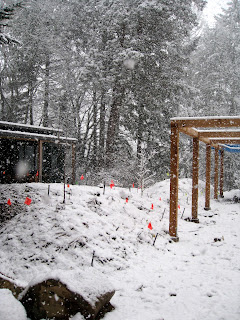Irrigation installation equipment: measuring wheel for finding distances, coloured flags to mark zones, grubbing mattock to dig trenches.
Mike Isacson, the owner of Island Waterwise Irrigation and assistant David, arrived in February to install an irrigation system in the backyard. I first met Mike several years ago at an irrigation workshop he had volunteered to run for the CRD. I was most impressed with his level of knowledge and his irrigation philosophy. He had been a landscape gardener before deciding to specialise in irrigation when he found so few people really understood what it should be.
There had been an extensive irrigation system before we started the Backyard Project but most of it got destroyed during construction. We did not try to preserve it because the whole area was to be reconfigured. New main pipes had to be installed in trenches.
It was tough going digging those trenches in the rocky soil. And the weather was cold.
The original system watered a huge lawn which covered most of the area that is now the Backyard Project. The new system focuses on new raised beds while the pergola, arbour, gravel bed garden and new paths do not need an irrigation system.
I had drawn a map dividing up garden beds into different areas with different water requirements. I walked around the site with Mike to explain the areas. Mike then walked around and visualised the different zones needed and marked them with different coloured flags.
We had made contact with Mike in the previous fall but he was very busy and not able to get to our place until February. I knew the garden beds would be dug up to lay the pipes so I planted only the tree in each bed and grew cover crops that needed to be dug in any way. By the time Mike arrived all of the cover crops had been killed off by the frost.
Each zone has its own coloured flag. I asked Mike to leave the flags in place so I could become familiar with each zone once we started using the irrigation system. We will program each zone according to how often and how much water it needs during the dry months.
This is the spade David used to dig the trenches, called a trenching spade, obviously. I was so impressed with how carefully he dug out the soil then replaced it after the pipe was laid.
David is laying pipe along the top of the Feather Hugelkultur Bed. Mike works along the fence in the new bed. You can tell it is cold by how well dressed they are - hat/toque, gloves and winter jacket are required.
Flexible pipe is installed in the trench then different fittings are attached depending on the type of irrigation needed.
One of the control areas for the different zones. This is covered with the green lid so it can be accessed when needed.
There were a couple of days during the installation when conditions were miserable. This day first the roofers stopped because they couldn't get the bitumen warm enough. Then Mike and David left because they couldn't see what they were doing. Josh and his crew left not long after because of the same problem. It was an unwanted Snow Day holiday.


















































